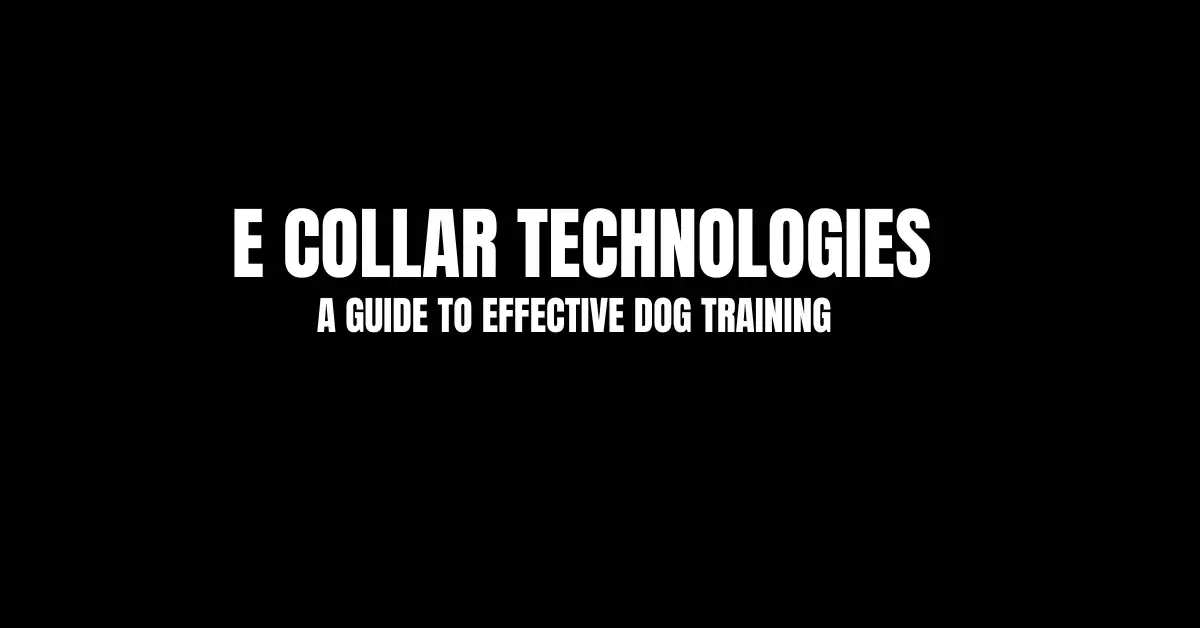E collar technologies have revolutionized dog training, providing safe, reliable tools to help improve obedience and communication with pets. These advanced collars, when used responsibly, offer a humane way to guide behaviors and enhance training results. Let’s dive into how e collar technologies work, their benefits, and tips for selecting the best option for your furry friend.
Table of Contents
ToggleWhat is E Collar Technology?
E collars, or electronic collars, are devices designed to assist with dog training. They work by delivering signals such as vibrations, sounds, or mild stimulations to capture a dog’s attention, enabling owners to reinforce positive behaviors or discourage negative ones effectively.
How E Collar Technology Works
E collars typically consist of two main parts: a remote controller and a receiver attached to the dog’s collar. When activated, the remote controller sends signals to the receiver, prompting a response based on the selected mode, such as sound, vibration, or mild static.
Types of E Collar Technologies
- Vibration Collars: These collars use gentle vibrations to gain the dog’s attention and are commonly used for training.
- Static Collars: Designed to deliver mild stimulation, static collars are mainly used for behavior correction.
- Sound Collars: These collars emit tones as cues, making them useful for basic training and obedience.
Primary Uses of E Collars
E collars are versatile, with applications in training, behavior correction, and obedience reinforcement. They are commonly used to guide dogs on boundaries, discourage excessive barking, and help reinforce specific commands.
E Collars for Training Dogs
For training purposes, E collars provide instant feedback, helping dogs associate actions with consequences. This can be especially effective for teaching obedience commands like “sit,” “stay,” and “come.”
E Collars for Behavior Correction
Behavior correction is another common use of E collars. They can be effective in reducing behaviors like excessive barking, digging, or leash pulling by allowing quick, on-the-spot corrections.
Advantages of Using E Collars
- Efficient Training: E collars allow for quick response times, reinforcing positive behaviors and correcting negative ones immediately.
- Customizable Settings: Various intensity levels enable adjustments based on the dog’s temperament.
- Remote Control: E collars allow pet owners to manage their dog’s behavior even from a distance.
Are E Collars Safe for Dogs?
When used correctly, E collars are generally safe and comfortable for dogs. Most modern collars include adjustable settings that prevent discomfort, but it’s essential to follow usage guidelines and consult professional trainers if necessary.
Choosing the Right E Collar for Your Dog
Selecting the right E collar depends on your dog’s size, breed, and temperament. For instance, vibration collars may be ideal for sensitive dogs, while static collars are more effective for stubborn or larger breeds.
Setting Up an E Collar
To set up an E collar, secure it comfortably around your dog’s neck and adjust the signal intensity. Testing the levels beforehand ensures safe and comfortable use, especially for static options.
Training Tips with E Collars
- Start Slow: Begin with the lowest setting to gauge your dog’s reaction.
- Combine with Rewards: Reinforce training with treats or praise to encourage positive behavior.
- Gradual Training: Start with basic commands and gradually progress to more complex tasks.
Challenges and Myths About E Collars
Several misconceptions surround E collars. For example, some believe they are harmful to dogs, yet studies indicate they are safe when used responsibly. Another myth is that E collars are a “quick fix” for training, though consistency and patience remain essential for effective training.
Innovations in E Collar Technologies
Recent innovations include GPS tracking, smartphone integration, and collars that adjust signals based on the dog’s responses. These advancements provide pet owners with more control and a better training experience.
Future Trends in E Collar Technologies
The future of E collar technology looks promising, with AI-driven responses and humane training methods on the horizon. Enhanced feedback mechanisms are also expected to improve the safety and effectiveness of dog training.
Conclusion
E collar technology has made dog training safer and more efficient for pet owners and trainers. With responsible use, E collars can help dogs learn quickly and effectively. Remember, patience and positive reinforcement are key to successful training outcomes.
FAQs
- Are E collars suitable for all dogs? E collars are generally safe but consult a trainer to choose the best type for your dog’s temperament.
- How long should I use an E collar on my dog? Short training sessions are recommended. Avoid prolonged use to prevent stress or overstimulation.
- Can E collars replace traditional training methods? No, they are best used as supplements alongside regular training techniques.
- Do E collars hurt dogs? When used properly, E collars do not harm dogs. It’s always advisable to start with the lowest intensity setting.
- How can I introduce an E collar to my dog? Introduce it gradually with positive reinforcement, and let your dog get accustomed to it before starting training sessions.





